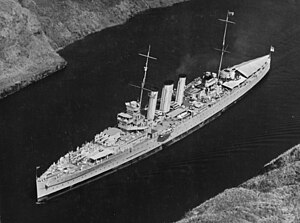


The history of the Royal Australian Navy traces the development of the Royal Australian Navy (RAN) from the colonisation of Australia by the British in 1788. Until 1859, vessels of the Royal Navy made frequent trips to the new colonies. In 1859, the Australia Squadron was formed as a separate squadron and remained in Australia until 1913. Until Federation, five of the six Australian colonies operated their own colonial naval force, which formed on 1 March 1901 the Australian Navy's (AN) Commonwealth Naval Force which received Royal patronage in July 1911 and was from that time referred to as Royal Australian Navy (RAN).[1] On 4 October 1913 the new replacement fleet for the foundation fleet of 1901 steamed through Sydney Heads for the first time.
The Royal Australian Navy has seen action in every ocean of the world.[2][3] It first saw action in World War I, in the Pacific, Indian and Atlantic oceans. Between the wars the RAN's fortunes shifted with the financial situation of Australia: it experienced great growth during the 1920s, but was forced to reduce its fleet and operations during the 1930s. Consequently, when it entered World War II, the RAN was smaller than it had been at the start of World War I. During the course of World War II, the RAN operated more than 350 fighting and support ships; a further 600 small civilian vessels were put into service as auxiliary patrol boats.[4] (Contrary to some claims, however, the RAN was not the fifth-largest navy in the world at any point during World War II.[5])
Following World War II, the RAN saw action in Korea, Vietnam, and other smaller conflicts. Today, the RAN consists of a small but modern force, widely regarded as one of the most powerful forces in the Asia Pacific Region.
- ^ John M Wilkins, Australian Naval Reserve publication
- ^ "HERITAGE". navy.defencejobs.gov.au.
- ^ Stevens, David. "The RAN - A Brief History". Navy - Serving Australia with Pride.
- ^ Cite error: The named reference
StraczekWW2was invoked but never defined (see the help page). - ^ The peak strength of the Royal Canadian Navy was 95,000 personnel on VE day, whereas the peak strength of the RAN, in mid-1945, was less than 40,000 personnel. While the RAN surpassed the RCN in terms of the number of vessels operated during 1939–45, both navies were dwarfed by the wartime fleets of the US, British, Soviet, Japanese, German, French and probably other navies. (Rob Stuart, 2009, "Was the RCN ever the Third Largest Navy?", Canadian Naval Review, vol. 5, no. 3, pp. 5–9.)
© MMXXIII Rich X Search. We shall prevail. All rights reserved. Rich X Search
